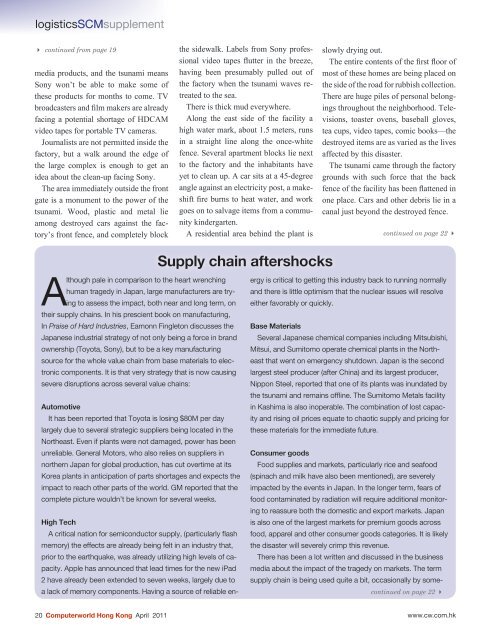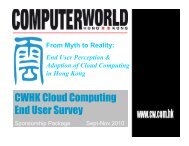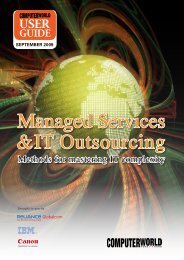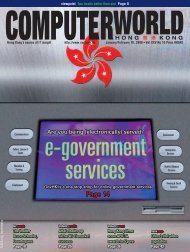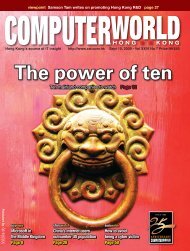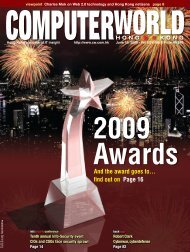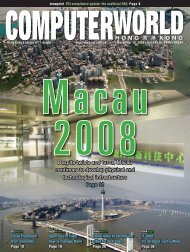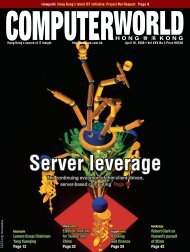Computerworld Hong Kong - enterpriseinnovation.net
Computerworld Hong Kong - enterpriseinnovation.net
Computerworld Hong Kong - enterpriseinnovation.net
- No tags were found...
You also want an ePaper? Increase the reach of your titles
YUMPU automatically turns print PDFs into web optimized ePapers that Google loves.
logisticsSCMsupplement4 continued from page 19media products, and the tsunami meansSony won’t be able to make some ofthese products for months to come. TVbroadcasters and film makers are alreadyfacing a potential shortage of HDCAMvideo tapes for portable TV cameras.Journalists are not permitted inside thefactory, but a walk around the edge ofthe large complex is enough to get anidea about the clean-up facing Sony.The area immediately outside the frontgate is a monument to the power of thetsunami. Wood, plastic and metal lieamong destroyed cars against the factory’sfront fence, and completely blockthe sidewalk. Labels from Sony professionalvideo tapes flutter in the breeze,having been presumably pulled out ofthe factory when the tsunami waves retreatedto the sea.There is thick mud everywhere.Along the east side of the facility ahigh water mark, about 1.5 meters, runsin a straight line along the once-whitefence. Several apartment blocks lie nextto the factory and the inhabitants haveyet to clean up. A car sits at a 45-degreeangle against an electricity post, a makeshiftfire burns to heat water, and workgoes on to salvage items from a communitykindergarten.A residential area behind the plant isslowly drying out.The entire contents of the first floor ofmost of these homes are being placed onthe side of the road for rubbish collection.There are huge piles of personal belongingsthroughout the neighborhood. Televisions,toaster ovens, baseball gloves,tea cups, video tapes, comic books—thedestroyed items are as varied as the livesaffected by this disaster.The tsunami came through the factorygrounds with such force that the backfence of the facility has been flattened inone place. Cars and other debris lie in acanal just beyond the destroyed fence.continued on page 22 4Supply chain aftershocksAlthough pale in comparison to the heart wrenchinghuman tragedy in Japan, large manufacturers are tryingto assess the impact, both near and long term, ontheir supply chains. In his prescient book on manufacturing,In Praise of Hard Industries, Eamonn Fingleton discusses theJapanese industrial strategy of not only being a force in brandownership (Toyota, Sony), but to be a key manufacturingsource for the whole value chain from base materials to electroniccomponents. It is that very strategy that is now causingsevere disruptions across several value chains:AutomotiveIt has been reported that Toyota is losing $80M per daylargely due to several strategic suppliers being located in theNortheast. Even if plants were not damaged, power has beenunreliable. General Motors, who also relies on suppliers innorthern Japan for global production, has cut overtime at itsKorea plants in anticipation of parts shortages and expects theimpact to reach other parts of the world. GM reported that thecomplete picture wouldn’t be known for several weeks.High TechA critical nation for semiconductor supply, (particularly flashmemory) the effects are already being felt in an industry that,prior to the earthquake, was already utilizing high levels of capacity.Apple has announced that lead times for the new iPad2 have already been extended to seven weeks, largely due toa lack of memory components. Having a source of reliable energyis critical to getting this industry back to running normallyand there is little optimism that the nuclear issues will resolveeither favorably or quickly.Base MaterialsSeveral Japanese chemical companies including Mitsubishi,Mitsui, and Sumitomo operate chemical plants in the Northeastthat went on emergency shutdown. Japan is the secondlargest steel producer (after China) and its largest producer,Nippon Steel, reported that one of its plants was inundated bythe tsunami and remains offline. The Sumitomo Metals facilityin Kashima is also inoperable. The combination of lost capacityand rising oil prices equate to chaotic supply and pricing forthese materials for the immediate future.Consumer goodsFood supplies and markets, particularly rice and seafood(spinach and milk have also been mentioned), are severelyimpacted by the events in Japan. In the longer term, fears offood contaminated by radiation will require additional monitoringto reassure both the domestic and export markets. Japanis also one of the largest markets for premium goods acrossfood, apparel and other consumer goods categories. It is likelythe disaster will severely crimp this revenue.There has been a lot written and discussed in the businessmedia about the impact of the tragedy on markets. The termsupply chain is being used quite a bit, occasionally by some-continued on page 22 420 <strong>Computerworld</strong> <strong>Hong</strong> <strong>Kong</strong> April 2011 www.cw.com.hk


